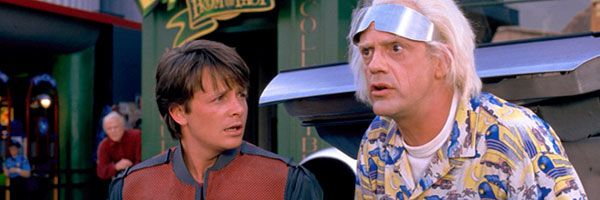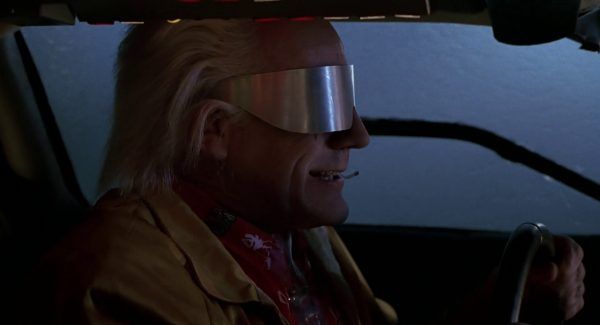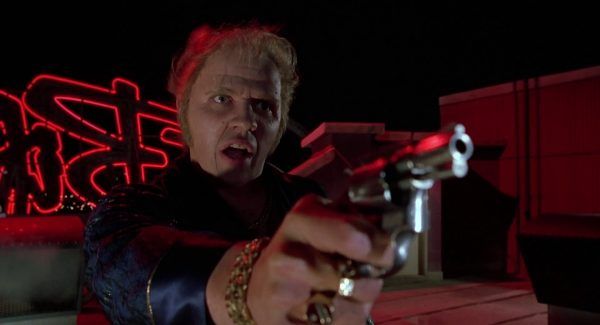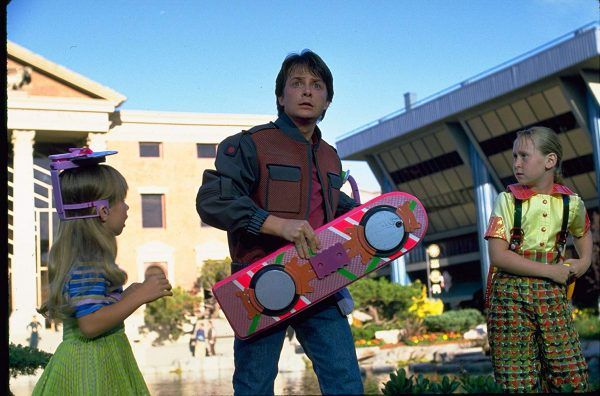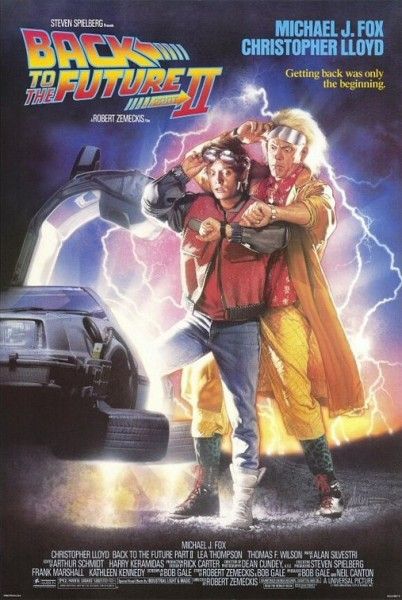“Where we’re going, we don’t need roads.” With this deliciously simple, tantalizing line of crisp screenwriting -- followed soon thereafter by the dope visual effect of a damn flying car -- objective masterpiece Back to the Future ends with a bang. The classic blockbuster, from director Robert Zemeckis and screenwriter Bob Gale, changed the game in 1985. Zemeckis initially wanted its story to end on his cliffhanger forever -- until, buoyed by returning stars Michael J. Fox and Christopher Lloyd, he was convinced to follow the car once it flies into the air. And boy am I glad he did.
Back to the Future Part II was released in theatres in 1989. In this year of our Lord 2019, it’s celebrating its 30th anniversary. And this milestone gives me the confidence to say something out loud I’ve only privately thought among my film fan friends: I think Part II just might be better than Part I. Yes, I know. I’m as wrong as Doc’s naysayers, I’m as dumb as Future Biff, I should make like a tree and get out of here. But if you’ll allow me the time, I would love to make my case as to why Back to the Future Part II is a better watch than the OG Back to the Future.
We Actually See the Future!
A simple distinction. But an important one, nonetheless. If you give me a title like Back to the Future, I expect to see the future. Yes, I know the first film’s usage of the title cleverly frames “the present” as “the future” they need to get “back to” having been stuck in 1955. But it also renders the film less as a pure sci-fi piece and more of a 1950s period piece with sci-fi window dressing. Why all the hoops to jump through, Double Bobby? (The nickname I’ve given Zemeckis and Gale, which I have totally earned the right to give) Why not just set a science fiction story in the dang future and have fun with the speculative fiction of it all? In Part II, they certainly got to, with delightful results.
The very first image we see after the cold open and title sequence (ooh, that Alan Silvestri score still slaps) is shocking to those familiar with the world of the first film. That work’s “1955 America” is photographed in bright, even flat lighting, presenting that era both sincerely and satirically as being “wholesome.” But our first image of 2015 feels more like Blade Runner than Leave It to Beaver. It’s dark and shadowy, with pops of green sticking out in an ominously cloudy grayish purple. Oh yeah -- and it’s in the sky. We fulfill the first film’s cliffhanger promise of flying cars right out of the gate, and it is an instantly enthralling leap into the futuristic frontier for the filmmakers. Much of the film’s futuristic look, especially in its night scenes, feel atypically grimy. Mad props to DP Dean Cundey and production designer Rick Carter for leaning into this space and crushing it.
This is not to say that Back to the Future Part II’s futurescape is overbearingly grim. One highly memorable chunk of the film comes from Marty investigating downtown in broad daylight, with eye-poppingly saturated colors and lewks filling the frame. Zemeckis and company remind us that teenagers, no matter the speculative era they exist in, crave and seek fun. And in stark contrast to many of the YA near-future dystopian narratives we’re inundated with, this sequence bounces with fun-seeking and achieving energy, even when some bullies are introduced. Plus, it makes the aforementioned dark stuff pop even harder. This flick’s got layers!
It’s Really Funny in a Lot of Different Ways!
The first film expertly juggles lots of different tones, moving from fish-out-of-water hijinks to pulse-pounding set pieces to heartwarming reconciliations and redemptions with ease. But Part II very consistently has comedy on its mind, perhaps even more so than science fiction. And not just the “confused man in the wrong time period” comedy from the first film -- though we do get a lot of that with Marty’s futuristic hijinks. Part II’s comedy is both broader and sharper -- and often dark in surprising ways.
There’s a ton of prescient satire embedded in Gale’s screenplay. Many online meme-purveyors have made mention on how Future Biff’s miserable attitude, wild hair, gaudily materialistic trappings, and inexplicable rise to power mirrors a certain United States President who was elected in 2016. I don’t want to belabor this likely reductive political point too much, but I will say this: It is very scary to watch this character do his thing in a post-2016 election society, and it is very satisfying and hopeful when he gets his just desserts. BTTF Part II’s satirical edge really sings for me when it puts our consumerist mediascape into its sights. Marty’s exploration of futuristic media feels so on the money to what’s currently going on. In maybe my favorite gag of the whole film, he’s attacked by a hologram rendering of a shark in an interactive advertisement for Jaws 19, directed by Max Spielberg (Tagline: This time it’s REALLY REALLY personal). Holograms resurrecting dormant celebrities? Film advertisement “experiences” that terrify real people? Neverending film franchises and reboots often made by the original creator’s direct family? BTTF Part II really has our number.
And it’s still really funny even when it’s not making a sociopolitical point -- just in a radically different way from the first film. Some of the extended comedy pieces in the film, particularly those that involve the nightmarish future versions of beloved characters, track closer to a Terry Gilliam or Jean-Pierre Jeunet vision of icky grotesqueries than Zemeckis’ generally optimistic disposition. And friends -- I’m about it! Huge props go to makeup designer Ken Chase and his entire team for turning his photogenic stars like Fox, Elizabeth Shue, Thomas F. Wilson, Lea Thompson, and Jeffrey Weissman (stepping in controversially for Crispin Glover as George McFly) into living Dark Crystal-era Muppets. The future McFly family dinner scene, staged in oppressively long takes marked by anxiety-inducing overlapping dialogue like some kind of Robert Altman fever dream, solidifies the sequel’s new identity quite effectively -- not to mention the sheer amount of fun you see from Michael J. Fox, who finally gets to play some darker, weirder notes in one of these films. Thankfully, all of these nightmares are eventually made right -- leaving Zemeckis’ generally optimistic disposition sunnily endorsed in a stronger way than if we’d never seen them at all.
It’s So Cleverly Constructed!
Back to the Future Part II opens, quite literally, with the last scene of the first film. The cast and crew redid it verbatim -- with a not unnoticed Elizabeth Shue stepping into the Jennifer role originally played by Claudia Wells, who left the franchise to take care of her ailing mother. But that’s not the only bit of meta-trickery on Double Bobby’s mind. Back to the Future Part II kicked open the door for mainstream works of sci-fi time travel trickery like 12 Monkeys, Looper, and friggin’ Avengers: Endgame. And it did so with elegant, impressive-to-this-day screenwriting and technological mastery.
The film folds in on itself, narratively and visually, all over the dang place. Present versions visit future versions, future versions visit past versions, and all interactions must be done very carefully, lest every potential timeline folds in on themselves and destroys the space-time continuum as we know it. Or, if you’re butthead Biff Tannen (Thomas F. Wilson), you just up and tell your past self directly and bluntly. This sequence, where the two Biffs meet and go over their sports almanac time-grift with the intellectual comprehension you might expect, is a masterclass in staging ingenuity. Taking early compositing technologies to their absolute limits, we watch the same character -- played by the same actor -- talk to each other in the same scene, in the same car, with no cuts. Heck, Cundey’s camera even does some moves while they chat! And they hand things to each other, cleverly hidden by the car’s frame! These types of sequences (not to mention a moment where Present Marty slinks and hides around Past Marty) are remarkable, annoyingly effortless-seeming, and downright revolutionary for what consumers can handle in blockbusters. And it gives me that “time-travel shenanigans” fix I was so desperately missing in the first installment.
It’s Got Iconography For Days!
If you were to ask someone to remember some of the most memorable images from Back to the Future, I’d bet you something like $8 that they’ll accidentally pick something from Part II. I’m just gonna list some of the memorable images and moments from the film -- many of which have been replicated, or happened coincidentally, in our current present, which is this film’s future.
The Sports Almanac, a figure of temptation so folks in the past can get rich off the results of the future? A beautiful, believable MacGuffin and symbol of temptation -- plus, it predicted the wild 2016 World Series win of the Chicago Cubs. The hoverboard, the self-lacing Nikes, the hat with the abstract colorscape? Currently being developed, a coworker literally has them on his desk, a friend literally wears it every time he goes out. And while Part II doesn’t have an equivalent moment to Part I’s indelible “Johnny B. Goode” sequence (which, I might add, does problematically rewrite history to assert that a black person stole rock and roll from a white person, rather than the true other way around), it does add an indelible characteristic to Marty McFly. I’m talking, of course, about the Chicken Berserk Button.
We find out in this film that if you call Marty “chicken,” he will lose his goddamn mind and deliver this perfect response: “Nobody calls me chicken.” Now, some might say this newfound quirk feels arbitrary, out of nowhere, or backs Marty into impossible corners no self-respecting protagonist should find themselves in. I see the argument -- he never says anything like this in the first film. But he does behave like that. He’s brash, cocky, bold, confident. And, need I remind you, a fun-loving teenager who plays rock guitar. Of course he’s not gonna like being called a chicken, and of course this iconic phrase is the perfect extension and encapsulation about his character.
Final Thoughts
I don’t know that it’s 100% fair to say Back to the Future Part II is “better” than Part I. Especially since so much of the pleasures of Part II need the solid, tight foundation of Part I to function, let alone thrive. And Part II likely doesn’t provide as emotionally rich an experience as the beautifully written and performed arcs in the first film. Part II is, instead, a well-oiled, shiny-ass machine of gags, technological feats of strength, and gutturally satisfying bits of pop culture iconography. And if you ask me to throw on one of these films for a casual, fun viewing experience… I’m gonna pick Part II just about every time. It’s a fast-paced, wild, hilarious, and fantastically crafted blockbuster that stands the test of time, using its predecessor’s engine to reach speeds much faster than 88mph. As for Part III, the Western-set finale… um… hey, wanna watch Part II again?

